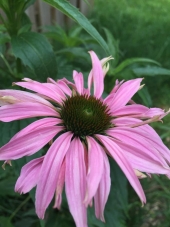
 1
1




Central Mississippi, Zone 8
 3
3




 2
2




John Daley Bendigo, Australia The Enemy of progress is the hope of a perfect plan
Benefits of rainfall collection https://permies.com/t/88043/benefits-rainfall-collection
GOOD DEBT/ BAD DEBT https://permies.com/t/179218/mortgages-good-debt-bad-debt
 3
3




"Study books and observe nature; if they do not agree, throw away the books." ~ William A. Albrecht




A human being should be able to change a diaper, plan an invasion, butcher a hog, conn a ship, design a building, write a sonnet, balance accounts, build a wall, set a bone, comfort the dying, take orders, give orders, cooperate, act alone, solve equations, analyze a new problem, pitch manure, program a computer, cook a tasty meal, fight efficiently, die gallantly. Specialization is for insects.
-Robert A. Heinlein




Central Mississippi, Zone 8
 1
1




"People may doubt what you say, but they will believe what you do."
 2
2




"Study books and observe nature; if they do not agree, throw away the books." ~ William A. Albrecht
 1
1




Moderator, Treatment Free Beekeepers group on Facebook.
https://www.facebook.com/groups/treatmentfreebeekeepers/





 1
1








John Daley Bendigo, Australia The Enemy of progress is the hope of a perfect plan
Benefits of rainfall collection https://permies.com/t/88043/benefits-rainfall-collection
GOOD DEBT/ BAD DEBT https://permies.com/t/179218/mortgages-good-debt-bad-debt








Leonard Burdek Iii wrote:It sounds like your issue is retaining moisture in the topsoil. Are you using any kind of mulch over it? Shredded leaves do wonders at retaining moisture, I've used straw over our sandy loam here in Michigan witho good results too.
Central Mississippi, Zone 8




John C Daley wrote:Following up on green manures etc
webpage
Central Mississippi, Zone 8








Leonard Burdek Iii wrote:Right, you're growing in the mulch, not the subsoil. My thinking is to mulch the broken down mulch you're growing in.
 1
1




A human being should be able to change a diaper, plan an invasion, butcher a hog, conn a ship, design a building, write a sonnet, balance accounts, build a wall, set a bone, comfort the dying, take orders, give orders, cooperate, act alone, solve equations, analyze a new problem, pitch manure, program a computer, cook a tasty meal, fight efficiently, die gallantly. Specialization is for insects.
-Robert A. Heinlein

 7
7




Greg B Smith wrote:A little clarification. The previous owner kept the ground swept clean so no leaf litter was allowed to stay. The clay was like concrete. I started out trying to double dig but after 2 hours I had a total of 32 square feet properly prepared. I gave up as I was looking at 1/3 an acre. I deep mulched and placed the beds as close to on contour as possible. Each beds are 30 inches wide and 40 feet long yielding 100 square ft each.
The whole thing is on a sight slope. When it rains, the water quickly passes through the compost to the clay layer. From there it moves off to the yard. The clay is softer now and moist but the rain still runs off.
I have planted lots of turnips, mustard, and other crops with long trap roots. When they reach the clay, they turn sideways and grow parallel with the clay but they do not penetrate it.
All of these things combined cause most of the rain to be lost. We receive about 50 inches of rain a year here. Heavy watering is still required if you are to grow a summer crop.
List of Bryant RedHawk's Epic Soil Series Threads We love visitors, that's why we live in a secluded cabin deep in the woods. "Buzzard's Roost (Asnikiye Heca) Farm." Promoting permaculture to save our planet.




Bryant RedHawk wrote:
Greg B Smith wrote:A little clarification. The previous owner kept the ground swept clean so no leaf litter was allowed to stay. The clay was like concrete. I started out trying to double dig but after 2 hours I had a total of 32 square feet properly prepared. I gave up as I was looking at 1/3 an acre. I deep mulched and placed the beds as close to on contour as possible. Each beds are 30 inches wide and 40 feet long yielding 100 square ft each.
The whole thing is on a sight slope. When it rains, the water quickly passes through the compost to the clay layer. From there it moves off to the yard. The clay is softer now and moist but the rain still runs off.
I have planted lots of turnips, mustard, and other crops with long trap roots. When they reach the clay, they turn sideways and grow parallel with the clay but they do not penetrate it.
All of these things combined cause most of the rain to be lost. We receive about 50 inches of rain a year here. Heavy watering is still required if you are to grow a summer crop.
Every one of the ideas that others have presented are good ones, I want to say that first because I am going to give you some ideas of how to attack this issue of a compact clay subsoil that will open it up within 6 months and it will only get better from there.
Since we know from your description that you have a barrier layer of clay, it will need to be cracked, the devices designed to do this are:
Broad fork, key line plow, sub soil plow, they all do pretty much the same thing, open the soil for water and air infiltration, the first one is people powered the others need a tractor to pull them. (Notice I didn't mention a Tiller! We grow soil not kill it.)
Your idea of planting deep root plants is really good except for the fact that you are not going to get through that barrier layer with them, as you found out, the roots will turn and follow the top of the barrier horizon layer.
Gypsum (powdered or small chunks), or AG Lime, are going to be your best friend when breaking a clay barrier layer, you want to get this amendment down to the clay, so spread it and then use the tool above of your choice to open channels for the amendment to travel down through.
Don't hold back on the Gypsum if you use that, soils can take almost as much as you want to apply, Gypsum is calcium so you are doing two things with one application without jumping your pH much, this is a good thing, pH adjusting should be done once you have that barrier broken up.
Gypsum is also long lasting where AG Lime is only good for a year or two. Severe cases do benefit from using AG Lime first then coming back with a Gypsum amendment, both times you open up the soil so they can sink in.
Once you have that barrier layer cracked open, your plants will thrive with deep roots doing more organic injections for you.
Redhawk
Central Mississippi, Zone 8
 5
5




"The rule of no realm is mine. But all worthy things that are in peril as the world now stands, these are my care. And for my part, I shall not wholly fail in my task if anything that passes through this night can still grow fairer or bear fruit and flower again in days to come. For I too am a steward. Did you not know?" Gandolf
 2
2








Central Mississippi, Zone 8












 5
5




List of Bryant RedHawk's Epic Soil Series Threads We love visitors, that's why we live in a secluded cabin deep in the woods. "Buzzard's Roost (Asnikiye Heca) Farm." Promoting permaculture to save our planet.
 2
2




Central Mississippi, Zone 8
 2
2




Central Mississippi, Zone 8
 1
1








Greg B Smith wrote: The pics below are composted wood chips that were put down 2 plus years ago. Also pictured is the compacted clay. Zone 8 Central Mississippi...
 1
1




B Permie wrote:
Greg B Smith wrote: The pics below are composted wood chips that were put down 2 plus years ago. Also pictured is the compacted clay. Zone 8 Central Mississippi...
I know it's a long shot but is there an update to this situation? I am in almost the exact situation, north central MS, at least 4 ft of clay, and I've been working on a solid layer of organic on top. The area had zero top soil when I moved here. I've now got about 7 inches of leaf and crass clippings that have been breaking down for a year or two, and it seems like this year things are growing well enough in it..
There is still a very obvious divide between clay and organic, and I don't know if it is worth fighting or not. I feel like "punching through" the clay would be an excercise in futility due to the depth, and I wonder if my best bet is to just bring in some soil to mix in and just garden on top of the clay? Or just keep waiting as the crawdads and fireants keep bringing up mounds of clay into the compost.


|
Goodbye moon men. Hello tiny ad:
The new permaculture playing cards kickstarter is now live!
https://www.kickstarter.com/projects/paulwheaton/garden-cards
|





